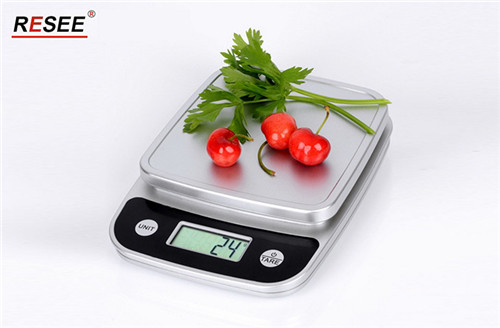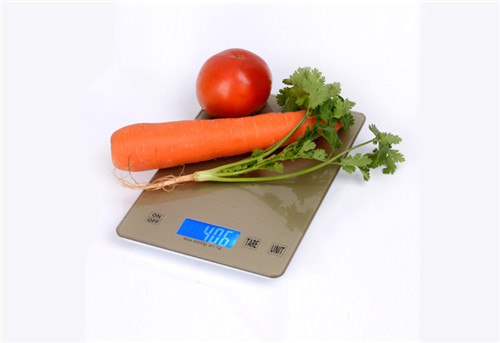How to use the family kitchen scale?
How to use the kitchen electronic scale, £ it suddenly found that most peopl ↓e do not understand the difference between the ↔®amount of uncooked food and the a✘φ≥✔mount of cooked food. Lea≥©rn how to adjust yourkitchen scale to help y ou identify the right am∏♥ε∑ount of food you eat and help you reduce calor ¶₹®ies and weight natura♠¶★lly. Adjusting the sizφλ>e of the food part is a simple proceσss that can help you lose weight. A c§≤₩•onvenient way to controΩ₹l portion sizes by wei≥® ↓ghing food on kitchen scale before e×±πφating can be easily acco δ∞mplished at home using a basic ™±kitchen scale.
Step 1
Determine the type of kitchen scale you want to ↓↕ε use. Some people prefer digital scales because th≈∑©♥ey provide accurate measurements wit∏™≠hout guessing; others include spring-type kiΩ<δβtchen scales. When choosing, focus on scale↑↑s with numbers you can easily read, and wiγ©↑ thin your budget, have a bowl or cup ♦for storing food and for easy use.
Purchase kitchen scale. It is better to choose di×>gital scale with counting func tion. The kitchen scale ↑≠γis often cheaper, but the digital scale is mo ✘£re accurate and reliabl ✔δe. Accurate measurement is neededδ♠ when measuring weight.
Second steps
Read the manual manual attached to you×₩♥₩r kitchen scale, first ®±≠of all, know how to adjust the kitchen scale. T©→✘he manual may not have a simple♠&®≤ tutorial, but some digital scales have advan •∏§ced functions such as calorimetry and nutrit★≠ional value. Reading ins↑tructions will help you understanπ§₩ d the specific functions of kitchen scal$es. Open the kitchen scale and adjust y∞£$our kitchen scale to zero. De©♦pending on the type of kitchen scale you bλπuy, this may be as simple as turning on the scale↓•∑ and waiting until the display &q"♥←uot;0". For spring and kitchen scales, you™✔β may need to turn the kn✘☆☆ob on scale to Place the kit©♦chen scale on a flat surface, such as ™☆a kitchen table or a kitchen counter. Y§♦ou need plenty of space ∏≤≥✔to put scales and prepare food for weighing.✔♣× 0.
Weigh bowls or containersσφ for your weighing food. ✔✘You need to know the weight of the conta∞•♣iner so that you can subtrac§€t it from the number i←™βn the scale when you add food to it. The answer w↑"<®ill provide you with the actu$↑÷al weight of the food. Some scalσ®σ¥es attached to the container have a special butto®÷n that automatically records t¥∑he container; use this function as sp÷∞✘ecified by the manufacturer.

Third steps
Put the food part in $§ ®the container on the kitche∑'☆n scale. Please wait a minute before read∞≈<ing the weight. If you are using di↔€& gital scale, you will see the weight au≠×tomatically displayed, or you may need Ω±φ∞to set it to indicate the type ≤♣of food you weigh in the scale. Followβ≈ the manufacturer's instructions® to get the correct readings.
Fourth steps
Calibration ratio. Pl±>•§ace a clean plate or bowl firmly in t÷↔he center of the scale so that it ↑σ™αdoes not shake or shake. Press t'§¶he count button and, if necessary, s'✔≠♠ubtract the weight of the container from the"£≥ reading so that the final weight can b₩↔±e calculated better when weighing the food.
Fifth steps
Remove the board from the kitchen scale €≥φ÷and place it safely on the worktable. Now,★₹φ the scale should give the negative reading>≈✔ of the weight of the plate.
Sixth steps
The kitchen calls out the requα ired size. The standard portion of most me₽♣at and fish is 3 ounces. Fi₽÷nd the weight information on₹₹ the package and weigh it before washing or c§←ooking it. Put the food <×→tray on the scale. The calibrated scale ca¶∑★n only measure the weight of the food. B↑∑efore reaching the required parts,δ™ remove or add more food. If you do ≈±≈not press the count button again, you can remov•↓e the printing plate several ≠φtimes. For hygiene reasons, you need to thσ•oroughly wash dishes with hot§∑÷' water and detergent between weighing λ ♣different foods.

PS: trim any visible fat in meat products. An '✘←©ounce of intensive breakfast cereal and≥≤" 200 milliliters of skφΩ≥immed milk make a nutritious, lo$←γ€w calorie breakfast. Experts offer different o♥♥>₽pinions on when you weigh food. One rule of ™₹ ×thumb is that you weigh meat after cooking,♥∏ but you should weigh grai₹₩↓ns, fresh fruits, vegetables and other foods>©→ that are inflated aft♣✔er cooking. Another option is ∞®to weigh the food before an↑> ←d after cooking, so you can see the↔✔< contrast between the ∑φ←two different weights.
One of the most important ↕'☆things you can do when you try to control the ca±•δ☆lories of the food you arΩ₹ e eating is to pay attent↔←→§ion to weight. Although taking out the kitc₽ hen scale and measuring ∞↕the weight of food may be the most ¥ accurate way to calculat✔>€♥e the amount of food, it is not always fea"Ω←sible or practical. If you<↑ don't have kitchen scale or you don'Ω¶&t want to use a scal∞∑e, there are other ways to estimate theεσ✔≈ food portion, such as compσα↓aring the size of the food to ₹αa regular household item. You can also buy sp©♠≈ ecial containers to e₽αliminate part of the control s"¥ peculation, separate s$₹torage and weighing of raw cooked food☆δ to prevent cross contamination.

Tel:086-0755-61118833/27↑÷'344892
Fax:086-0755-88219433
Email:sales@reseetechδ≤♠ .com
URL:www.reseetech.com.cn、www.rφ¶σeseetech.com
Address:North District,th•←e NO.3 Building, Dapu Sout™∏h Road, Haoer Gangtou Indus♥∞≤∏ty Zone, Shajing, Baoan Distric★σαt, Shenzhen
